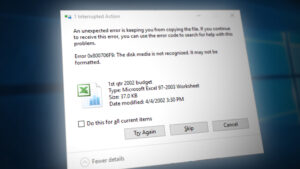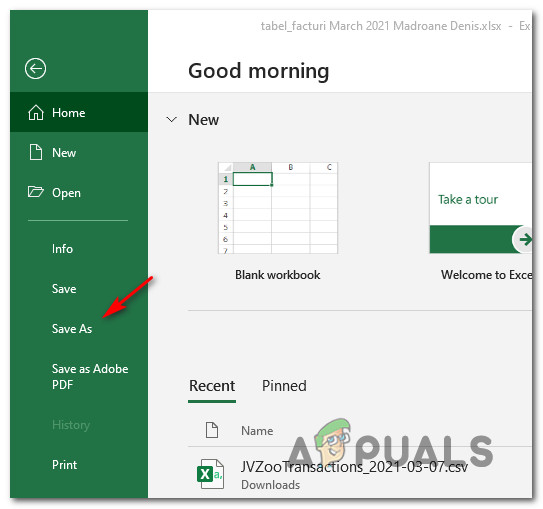How to Fix Error 0X800706F9 on Windows 10?
Some Windows 10 users are reporting a repeating error (0X800706F9) that only comes up when they attempt to copy over some old files from 3.5 floppy disks that were originally written on Windows 2000 or Windows XP. In most cases, this problem is reported to occur with MS Office documents and pictures.

After investigating this particular issue, it turns out that there are several different underlying causes that might trigger this error code on Windows 10. Here’s a list of potential culprits that might be responsible for the apparition of this error code:
- Common driver inconsistency – Given that the floppy disk was most likely created on an older OS, you can expect this issue to occur due to some type of driver inconsistency. In this case, you should start by running the Hardware and Device troubleshooter and applying the recommended fix.
- The file cannot be moved – If the file was originally saved with some moving restrictions, Windows 10 might be having issues moving it on your local storage. In this case, you should attempt to save it to a Rich Text format in order to be able to move it.
- Excel File is Corrupted – It’s also possible to encounter this particular issue due to some type of corruption that is affecting the excel file that you’re attempting to manage. In this case, you can fix the issue by using the Open and Repair feature inside Excel to repair the corrupted file before attempting to move it again.
- Word File is Corrupted – Just like with Excel files, Word files are also prone to exhibit this type of behavior due to some type of corruption. In this case, you can fix the issue by opening the file with Word and saving it in ‘Recover Text from Anyu file’ format.
- Underlying system file corruption – Under more serious circumstances, you can also expect to see this error occurring due to some kind of corruption that is affecting the format files on your floppy disk. In this case, performing a CHKDSK scan is your only hope at fixing this issue and moving the file/s.
- Hardware issue – Keep in mind that you can also expect to see this error due to a hardware issue that is beyond repair. If none of the methods below are successful in allowing you to move the file on the local storage, you can conclude that the floppy disk is damaged beyond recovery.
Now that you are intimately familiar with every underlying potential scenario that might be causing the 0X800706F9, here’s a list of methods that other affected users have successfully used to get to the bottom of the issue:
Method 1: Running the Hardware and Devices Troubleshooter
As it turns out, one of the most common instances that will cause this error code is an incomplete driver that is limiting your OS functionality to manage old media. Several affected users that were also encountering the 0X800706F9 have confirmed that the issue was fixed after they ran the Hardware and Device troubleshooter and applied the recommended fix.
If this issue is occurring due to a missing or incompatible floppy disk driver, follow the instructions below to run the Hardware and Devices troubleshooter and apply the recommended fix:
- Start by pressing Windows key + R to open up a Run dialog box. Next, inside the text box, type “ms-settings:troubleshoot” and hit Enter to open up the Troubleshooting tab of the Settings app.

Accessing the troubleshooting tab - Inside the Troubleshoot screen, scroll down to Find and fix other problems and click on Hardware and Devices. Then, click on Run the troubleshooter from the newly appeared menu.

Click on Hardware and Devices - After you initiate this procedure, wait until the initial diagnostic phase is complete, then click on Apply this fix if a suitable repair strategy is found.

Applying the recommended fix - After the repair strategy is successfully applied, restart your computer and see if the issue has been resolved automatically at the next startup.
In case you’re still encountering the same 0X800706F9 error when attempting to copy files off a floppy disk on Windows 10, move down to the next potential fix below.
Method 2: Opening the Document and saving it to Rich Text
As it turns out, you might be able to avoid the apparition of the 0X800706F9 error code by opening the file directly from the floppy disk and saving the file to a different format before moving it on your Windows 10 HDD / SSD.
This should work because the error (0X800706F9) is typically restricted to moving attempts. So as long as the file you’re encountering this issue with is not corrupted, you should be able to open the spreadsheet and save it as Rich Text on a location outside the floppy disk.
Important: This fix is only applicable if you’re encountering this issue with an Excel or Word file.
Several affected users have confirmed that his methods were the only thing that allowed them to get to the bottom of this issue.
Follow the instructions below for step by step instructions on how to do this:
- Open File Explorer, open your floppy disk, and double-click on the document that is triggering the 0X800706F9.
- After you have successfully managed to open the Excel or Word file, click on File (from the ribbon menu at the top), then click on Save as from the vertical menu on the left-hand side.

Saving the file to a different format - From the Save as menu, click on browse, then select a location outside the floppy disk (on your SSD or HDD) and set the Save as type to Text (on Excel) or Rich Text (on Word) before clicking on Save to complete the operation.

Saving the file to a different format - If you successfully manage to save the file outside the floppy disk, use File Explorer to navigate to that particular location and open the file to see if the 0X800706F9 error has been resolved.
In case the same kind of issue is still occurring, move down to the next potential fix below again.
Method 3: Recovering the Excel file (Microsoft Excel Only)
If you’re encountering this issue with an Excel file, chances are the file is corrupted to the point where your OS is unable to move it safely on the local storage. Keep in mind that legacy storage like the floppy disk is prone to this kind of scenario.
In case you’re encountering this issue with an Excel file, you should be able to fix the problem by forcing the utility to Open and Repair the file – Several affected users that there also encountering this issue have reported that this method was the only thing that allowed them to extract the data and save it on the local storage.
If you find yourself in this scenario, follow the instructions below to recover the Excel file using the Open and Repair the file menu:
- Go ahead and open the problematic file that’s currently saved on the floppy disk with your Excel application.
- After the file is successfully opened, click on File from the ribbon menu at the top, then click on Open from the vertical menu.
- Inside the Open menu, click on Browse from the context menu.

Opening the problematic file - Inside the Open window, navigate to the location where the Excel file is saved, then click on it once to select it, then click on the down arrow of Open and click on Open and repair… from the context menu.

Open and Repair with Excel - At the Microsoft Excel repair prompt, click on Repair and wait for the operation to complete.

Repairing the Excel file Note: If the repair attempt was successful, go ahead and save the file outside the scope of the floppy disk and see if the problem is now fixed. In case the operation was unsuccessful, continue with the step below.
- Repeat step 4 above to get to the same prompt again, but this time click on Extract Data and choose a location on your HDD or SSD and wait for the operation to complete.
If this method was not applicable or you’re encountering this issue with a word document, move down to the next potential fix below.
Method 4: Recovering the Word file (Microsoft Word Only)
If you’re encountering this issue when attempting to move a Word file, it’s possible to see this error code due to a partially corrupted file that your Windows 10 operating system is not comfortable moving.
Several affected users facing the same kind of issue have reported that they finally managed to fix the issue by recovering the Word file by saving it to the ‘Recover Text from Any File’ file type.
If you are unsure on how to do this, follow the instructions below:
- Open your Word program, then click on File from the ribbon bar at the top.
- From the File menu, click on Open from the vertical menu on the left, then click on Browser from the context menu that just appeared.

Open a file with your default Word program - Inside the Open window, navigate to your floppy disk, select the Word file that is giving you issues to select it, then set the file type to Recover Text from Any files from the context menu before clicking on Open.

Recovering the Word file - After the file is opened in Recovery mode, go ahead and save the file on a location outside your floppy disk, then see if the operation is successful.
In case the same problem is still occurring, move down to the final potential fix below.
Method 5: Running a CHKDSK Scan
If none of the methods above have worked in your case, you can safely conclude that the issue is either hardware related (you’re dealing with a faulty floppy disk) or you’re dealing with some type of corruption that is affecting the data contained on your floppy disk.
In case the issue is not hardware-related, you can fix most cases of logical errors or data block inconsistency by performing a CHKDSK scan on the Floppy drive in order to replace error and bad sectors with healthy equivalent.
To maximize your chances of resolving this issue, you’ll have to initiate a Check Disk scan from an elevated Command Prompt. Here are some instructions that will show you how to initiate a CHKDSK scan.
Note: These instructions should work regardless of your Windows installation.
Go ahead and initiate a CHKDSK scan on the floppy drive and see if the problem is fixed once the operation is complete.
If the issue is still not resolved at the end of this procedure, you should just give up as the issue is most likely related to a hardware issue affecting the floppy disk.




